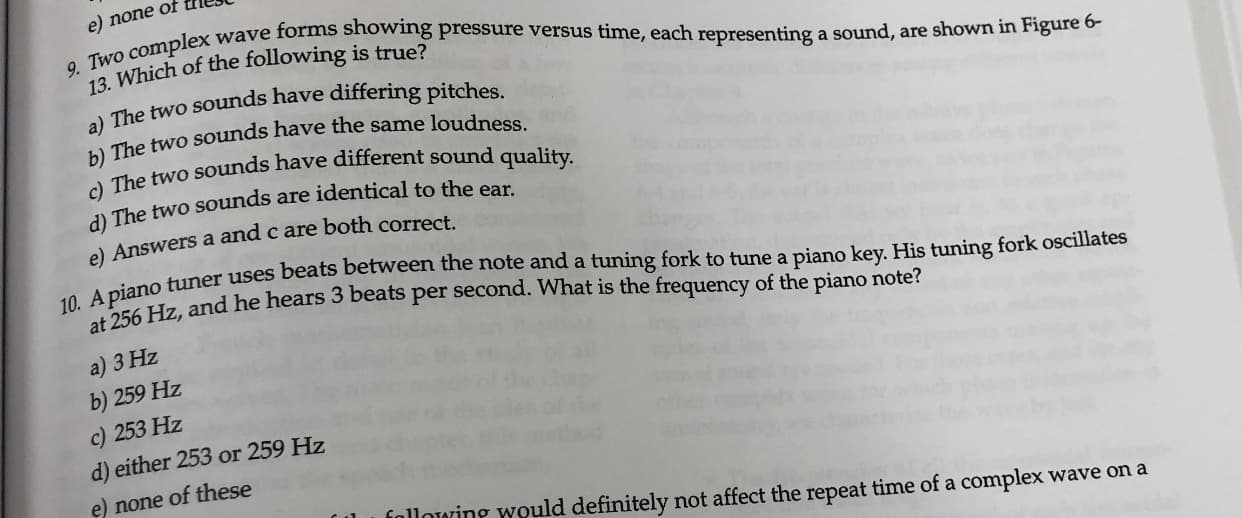e) none of t! 9. Two complex wave forms showing pressure versus time, each representing a sound, are shown in Figure 6- 13 Which of the following is true? a) The two sounds have differing pitches. b) The two sounds have the same loudness. c) The two sounds have different sound quality. d) The two ounds are identical to the ear. e) Answers a and c are both correct. 10. Apiano tuner uses beats between the note anda tuning fork to tune a piano key. His tuning fork oscillates at 256 Hz, and he hears 3 beats per second. What is the frequency of the piano note? a) 3 Hz b) 259 Hz c) 253 Hz d) either 253 or 259 Hz e) none of these iollowing would definitely not affect the repeat time of a complex wave on a
e) none of t! 9. Two complex wave forms showing pressure versus time, each representing a sound, are shown in Figure 6- 13 Which of the following is true? a) The two sounds have differing pitches. b) The two sounds have the same loudness. c) The two sounds have different sound quality. d) The two ounds are identical to the ear. e) Answers a and c are both correct. 10. Apiano tuner uses beats between the note anda tuning fork to tune a piano key. His tuning fork oscillates at 256 Hz, and he hears 3 beats per second. What is the frequency of the piano note? a) 3 Hz b) 259 Hz c) 253 Hz d) either 253 or 259 Hz e) none of these iollowing would definitely not affect the repeat time of a complex wave on a
College Physics
10th Edition
ISBN:9781285737027
Author:Raymond A. Serway, Chris Vuille
Publisher:Raymond A. Serway, Chris Vuille
Chapter14: Sound
Section: Chapter Questions
Problem 17P: The toadfish makes use of resonance in a closed tube to produce very loud sounds. The tube is its...
Related questions
Question
9&10

Transcribed Image Text:e) none of t!
9. Two complex wave forms showing pressure versus time, each representing a sound, are shown in Figure 6-
13 Which of the following is true?
a) The two sounds have differing pitches.
b) The two sounds have the same loudness.
c) The two sounds have different sound quality.
d) The two ounds are identical to the ear.
e) Answers a and c are both correct.
10. Apiano tuner uses beats between the note anda tuning fork to tune a piano key. His tuning fork oscillates
at 256 Hz, and he hears 3 beats per second. What is the frequency of the piano note?
a) 3 Hz
b) 259 Hz
c) 253 Hz
d) either 253 or 259 Hz
e) none of these
iollowing would definitely not affect the repeat time of a complex wave on a
Expert Solution
This question has been solved!
Explore an expertly crafted, step-by-step solution for a thorough understanding of key concepts.
This is a popular solution!
Trending now
This is a popular solution!
Step by step
Solved in 3 steps

Knowledge Booster
Learn more about
Need a deep-dive on the concept behind this application? Look no further. Learn more about this topic, physics and related others by exploring similar questions and additional content below.Recommended textbooks for you

College Physics
Physics
ISBN:
9781285737027
Author:
Raymond A. Serway, Chris Vuille
Publisher:
Cengage Learning

College Physics
Physics
ISBN:
9781305952300
Author:
Raymond A. Serway, Chris Vuille
Publisher:
Cengage Learning

Physics for Scientists and Engineers, Technology …
Physics
ISBN:
9781305116399
Author:
Raymond A. Serway, John W. Jewett
Publisher:
Cengage Learning

College Physics
Physics
ISBN:
9781285737027
Author:
Raymond A. Serway, Chris Vuille
Publisher:
Cengage Learning

College Physics
Physics
ISBN:
9781305952300
Author:
Raymond A. Serway, Chris Vuille
Publisher:
Cengage Learning

Physics for Scientists and Engineers, Technology …
Physics
ISBN:
9781305116399
Author:
Raymond A. Serway, John W. Jewett
Publisher:
Cengage Learning

Physics for Scientists and Engineers: Foundations…
Physics
ISBN:
9781133939146
Author:
Katz, Debora M.
Publisher:
Cengage Learning


Physics for Scientists and Engineers with Modern …
Physics
ISBN:
9781337553292
Author:
Raymond A. Serway, John W. Jewett
Publisher:
Cengage Learning